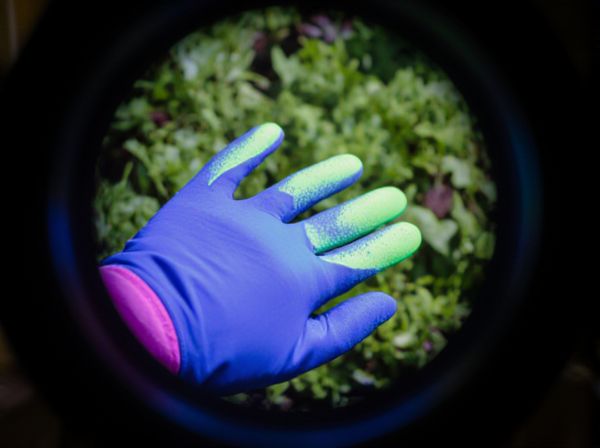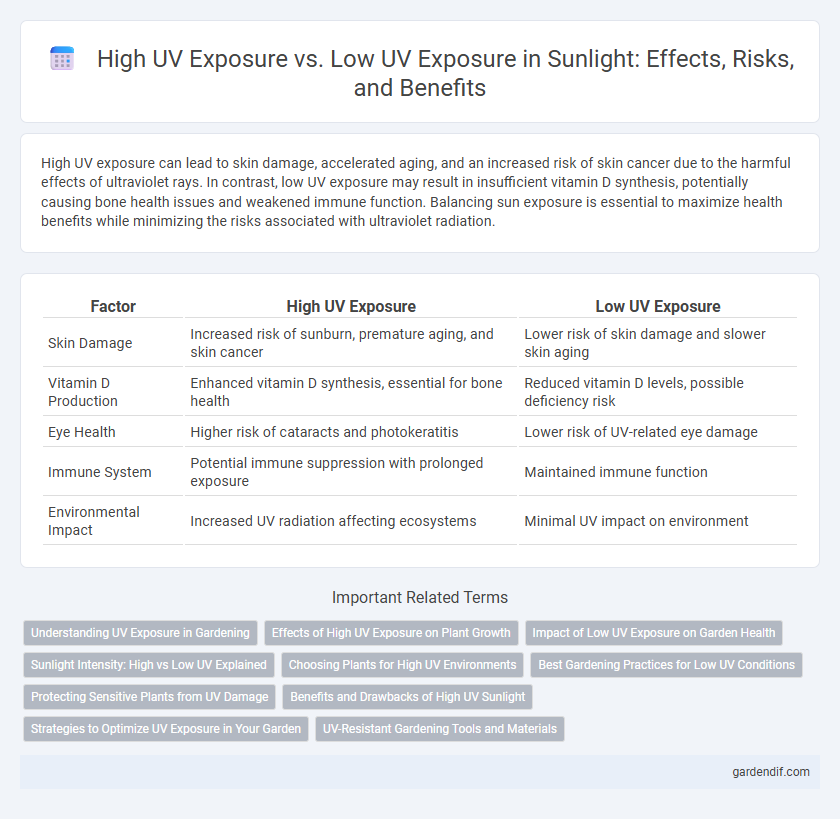
High UV exposure vs low UV exposure Illustration
High UV exposure can lead to skin damage, accelerated aging, and an increased risk of skin cancer due to the harmful effects of ultraviolet rays. In contrast, low UV exposure may result in insufficient vitamin D synthesis, potentially causing bone health issues and weakened immune function. Balancing sun exposure is essential to maximize health benefits while minimizing the risks associated with ultraviolet radiation.
Table of Comparison
| Factor | High UV Exposure | Low UV Exposure |
|---|---|---|
| Skin Damage | Increased risk of sunburn, premature aging, and skin cancer | Lower risk of skin damage and slower skin aging |
| Vitamin D Production | Enhanced vitamin D synthesis, essential for bone health | Reduced vitamin D levels, possible deficiency risk |
| Eye Health | Higher risk of cataracts and photokeratitis | Lower risk of UV-related eye damage |
| Immune System | Potential immune suppression with prolonged exposure | Maintained immune function |
| Environmental Impact | Increased UV radiation affecting ecosystems | Minimal UV impact on environment |
Understanding UV Exposure in Gardening
High UV exposure in gardening promotes the synthesis of essential plant compounds like flavonoids and antioxidants, enhancing plant health and resistance to pests. Low UV exposure can result in weaker plant structures and increased susceptibility to diseases, potentially reducing crop yield and quality. Effective UV management balances exposure to optimize photosynthesis while minimizing damage from excessive ultraviolet radiation.
Effects of High UV Exposure on Plant Growth
High UV exposure damages plant DNA, reduces photosynthesis efficiency, and causes oxidative stress, leading to stunted growth and lower biomass accumulation. Excessive ultraviolet radiation disrupts chlorophyll formation, resulting in chlorosis and impaired nutrient absorption. Plants exposed to high UV levels often develop thicker cuticles and increased flavonoid production as protective mechanisms, but these adaptations may divert energy from growth processes.
Impact of Low UV Exposure on Garden Health
Low UV exposure in gardens results in reduced photosynthesis, leading to slower plant growth and weaker structural development. Insufficient UV light diminishes the production of essential secondary metabolites in plants, making them more vulnerable to pests and diseases. Consequently, gardens with low UV exposure experience less vibrant foliage and lower crop yields.
Sunlight Intensity: High vs Low UV Explained
High UV exposure occurs when sunlight intensity is strong, typically during midday or in regions near the equator, increasing the risk of skin damage and the need for protective measures like sunscreen and clothing. Low UV exposure happens during early morning, late afternoon, or in areas with cloud cover, reducing the intensity of ultraviolet rays and the potential for harmful effects. Understanding the variation in UV intensity helps optimize sun safety practices to balance vitamin D synthesis and skin health.
Choosing Plants for High UV Environments
Plants selected for high UV environments must possess strong UV tolerance, often characterized by thick, waxy cuticles and dense trichomes that protect against damage. Species such as succulents, cacti, and native grasses exhibit robust UV resistance and maintain photosynthetic efficiency under intense sunlight. Conversely, plants adapted to low UV exposure typically have thinner leaves and may require shading to prevent leaf scorch and impaired growth.
Best Gardening Practices for Low UV Conditions
Low UV exposure limits the natural stimulation of plant growth, necessitating alternative gardening practices such as using growth-enhancing LED lights that mimic the UV spectrum. Implementing soil enrichment techniques with organic compost and maintaining consistent moisture levels promote healthier root development under diminished UV conditions. Selecting shade-tolerant plant species like ferns, hostas, and begonias ensures optimal growth and aesthetic appeal in environments with limited ultraviolet light.
Protecting Sensitive Plants from UV Damage
High UV exposure can cause significant damage to sensitive plants by breaking down chlorophyll, leading to leaf burn and stunted growth. Low UV exposure helps maintain plant health by reducing oxidative stress and preserving cellular integrity. Protective measures such as shade cloths or UV-blocking films are essential for safeguarding delicate plants from harmful ultraviolet radiation.
Benefits and Drawbacks of High UV Sunlight
High UV exposure from sunlight enhances vitamin D synthesis, boosting immune function and improving mood through increased serotonin production. However, excessive UV radiation significantly raises the risk of skin cancer, premature aging, and eye damage such as cataracts. Balancing UV exposure is crucial to harness its health benefits while minimizing harmful effects on skin and overall well-being.
Strategies to Optimize UV Exposure in Your Garden
High UV exposure boosts plant photosynthesis and vitamin D synthesis but may cause leaf burn and dehydration, while low UV exposure slows growth and reduces flowering. Strategies to optimize UV exposure in your garden include positioning sun-sensitive plants in partial shade, using UV-transparent greenhouse materials, and implementing adjustable shading systems to balance light intensity. Regular monitoring of plant responses and soil moisture ensures a healthy garden ecosystem with ideal UV levels.
UV-Resistant Gardening Tools and Materials
High UV exposure accelerates the degradation of gardening tools and materials, making UV-resistant products essential for durability and long-term use. Tools crafted from UV-stabilized plastics and metals with protective coatings maintain their structural integrity and functionality under intense sunlight. Utilizing UV-resistant gardening materials reduces maintenance costs and ensures consistent performance in outdoor environments with varying UV levels.
High UV exposure vs low UV exposure Infographic

 gardendif.com
gardendif.com